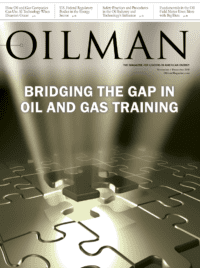Among the industries at risk for health and safety hazards, the oil industry is one of the most susceptible. Oil and gas workers are consistently exposed to hazards such as confined spaces, motor vehicle accidents, slips, trips, and falls, and especially, fires and explosions. When workers succumb to such hazards, it is not only detrimental to the worker, their health, and performance, but also to the performance and reputation of the company.
Companies can face costly fees/lawsuits, penalties, and ultimately incur damage to their brand and image. With that said, it is important for all three segments of the oil and gas industry (upstream, midstream, and downstream) to ensure safe and healthy work sites through various measures. Isaac Dantin, Senior Safety Manager at Danos, understands the importance of HSE (Health, Safety and Environmental) practices in the workplace and describes how such practices are implemented at Danos. He talks about how his company and others in the oil industry are able to stay on top of safety practices and procedures through various methods, and even more so through the use of technology.
When initially asked about the importance of HSE practices in the workplace and the industry, Dantin stated, “Workplace safety is not a priority, but a value. At Danos, it is the core of who we are. It is critical and essential. Safety is the lifeline of our success. The health and wellbeing of our employees come first. Safety means that we also meet or exceed our customer’s expectations. We want to make sure our employees are managing every procedure properly, and we want them to go home the same way they came in that morning.”
Dantin was also asked to discuss specific practices implemented at Danos. He described how Danos is a diverse service provider, mentioning that they have different product lines including production operations, construction, automation services, scaffolding, coatings and project management, and therefore, policies (including training details and behavioral-based safety programs) are made readily available on their internal company site. Dantin also credited how technology has had a hand in helping Danos commit to workplace safety. “We have an app that we created two years ago, which allows our employees to observe others perform tasks. It also allows management to give feedback. If an employee records a near miss in the field, the app sends an email to the management team. From there, we are allowed to get “in the bucket” with them and can help them work through their job tasks and take advantage of learning opportunities. We encourage employees to use our system to record observations, and there are no repercussions,” said Dantin.
Further describing the app that is simply called “Danos Watch Card,” Dantin said, “It is not only designed for our employees, but also for our customers and family members. They are also able to participate in our safety program. If a teenager notices something unsafe at home, they are able to enter an observation as a third party user. We will use the data they submit to help communicate with our broader organization. All you have to do is go to your app store on any smart device, search Danos, and register as a guest.”
Dantin also discussed other technological developments that Danos uses to improve worker health and safety conditions. “With our internal program called EMS (Electronic Management System) employees can access all their personal training and track the participation of our different safe work practices. Our EMS program is where we document our safety action plan goals. Staff and personnel participate in our safe work initiatives including hand & JSEA audits, offshore visits, crew change meetings, and our Stop Work and BSS (Behavioral Based Safety Program),” said Dantin.
When asked if he thought technology, overall, could help improve conditions in the oil industry, Dantin described how beneficial technology has been for the industry and Danos, and how heavily sought after it is by both customers and competitors. “I recently attended an offshore meeting in Houston with some other suppliers, and technology is something that everyone is focusing on. At Danos, we are also seeking a technological answer to our current app. Our app is designated for BBS, but we hope to implement and capture audits in the field through the app as well. With technology, we have been able to advance our data analytics. Just by entering safety information into our app, we can better gauge where we’re at in our learning opportunities and our successes,” said Dantin.
Dantin also described some of the HSE safety practices he has seen from other companies in the oil and gas industry. He expressed how more companies are starting to have compassion for human performance and are becoming more fixated on how to improve operations to better accommodate employees. “Everyone in the oil field is doing a good job of looking beyond the human element and instead, focusing on process improvement. People will make mistakes, but instead of solely analyzing if that human’s mistake is acceptable, we are now thinking about what we can do to better improve operations to prevent or reduce mistakes. It’s a better way of thinking,” said Dantin.
Dantin expressed what health and safety improvements, technological-based or otherwise, he’d like to see happen in the oil industry and for his company in the future. He emphasized how the industry should be measured more on the safeguards that are already in place. “Rather than looking at incidents for being the measuring stick of a safety culture, we should be looking at the positive, proactive things that a company does. I would also like to see more personal safety and care across the industry from the top down,” said Dantin.
Dantin shared how Danos does a great job of focusing on a positive and a caring workplace, but that there is room for everyone to improve. “When I started with Danos in 1996 as a roustabout, it meant the world to me to shake the hand of an owner or executive. Our employees have that opportunity quite often. Our executive team doesn’t have shiny new steel toe boots, but rather scuffed and dirty ones. Their boots will tell you that they spend time in the field face to face with the people we are working hard to protect. The industry needs to continue that push, the “We Care” push,” said Dantin.
Tonae’ Hamilton has been a contributor and associate editor to the magazine for two years. She has been writing professionally for almost four years. In her free time, Tonae’ likes to spend time with her three pets, cook, and binge-watch Netflix shows. Tonae' has a Bachelor of Arts in Communication from McDaniel College.










